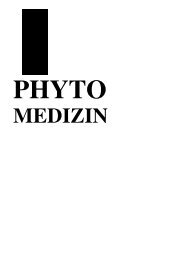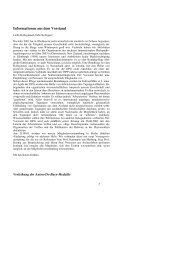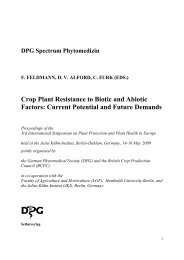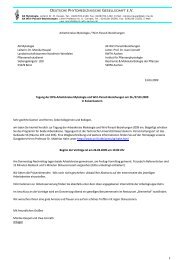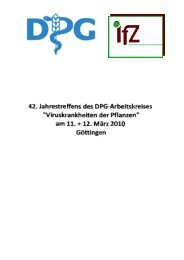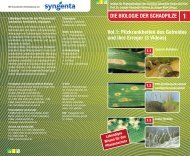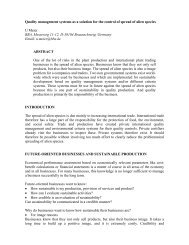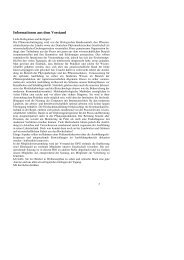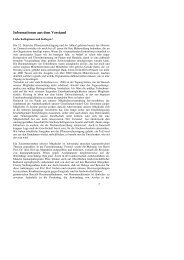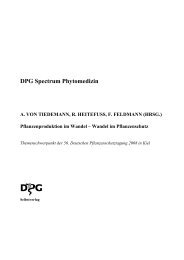PHYTO MEDIZIN Mitteilungen der Deutschen ... - Die DPG
PHYTO MEDIZIN Mitteilungen der Deutschen ... - Die DPG
PHYTO MEDIZIN Mitteilungen der Deutschen ... - Die DPG
Erfolgreiche ePaper selbst erstellen
Machen Sie aus Ihren PDF Publikationen ein blätterbares Flipbook mit unserer einzigartigen Google optimierten e-Paper Software.
spread in various ornamental plant species belonging to the Scrophulariaceae<br />
and Verbenaceae. Judged from its gene content, the folding properties of its<br />
5’untranslated region and from in vitro translation experiments, NeRNV<br />
RNA is a typical tymovirus RNA. Its 3’end, however, differs greatly from<br />
those of the valine-specific tymoviral RNAs which have been analysed previously.<br />
It can be folded into an upstream pseudoknot domain (UPD) and a<br />
histidine-specific tRNA-like structure (TLS), a combination which so far has<br />
been found only for tobamoviral RNAs. The identity elements found in<br />
NeRNV RNA for the recognition by yeast histidyl-tRNA synthetase are more<br />
similar to those of yeast tRNA His than the ones found in Tobacco mosaic<br />
virus (TMV) RNA. As a result NeRNV RNA can be charged with histidine<br />
even more efficiently than TMV RNA.<br />
Identification and detection of a closterovirus from carrot in Germany<br />
W Menzel, D-E Lesemann and HJ Vetten; Fe<strong>der</strong>al Research Center for Agriculture<br />
and Forestry, Institute for Plant Virology, Microbiology and Biosafety, Braunschweig<br />
Following dsRNA isolation from a stunted and chlorotic carrot plant growing<br />
in a seed propagation plot near Bingenheim, Hessen, Germany, a complex<br />
pattern of dsRNA bands was obtained. Since one of the dsRNAs had a notably<br />
high molecular weight, it was used as starting material for random RT-<br />
PCR, cloning and sequencing. Several clones were obtained which shared<br />
sequence similarity with viruses of the genus Closterovirus. A stretch of<br />
about 12,000 nucleotides comprising the complete 3’ half of the genome of<br />
the carrot closterovirus (CCV) was sequenced and analysed. Based on the<br />
hsp70h gene, which is commonly used for illustrating relationships in the<br />
family Closteroviridae, CCV is most closely related to Beet yellow stunt<br />
virus and Beet yellows virus, with which it shares hsp70h amino acid sequence<br />
similarities of 49% und 48% respectively. Moreover, CCV has a<br />
genomic organisation characteristic of the genus Closterovirus and, thus, can<br />
be confidently assigned to the genus Closterovirus of the family Closteroviridae.<br />
In attempts to develop a serological detection method for CCV, the<br />
major coat protein (CP) gene of CCV was expressed in E. coli and the resulting<br />
protein preparation was used for polyclonal antibody (PAb) production in<br />
a rabbit. These PAbs allowed visualisation of numerous closterovirus-like<br />
particles by immunosorbent electron microscopy. CCV particles had a normal<br />
length of 1600 nm and a width of 12 nm. In Western-blot experiments,<br />
the PAbs reacted with a protein band of about 25 kDa which was only present<br />
in CCV-infected but not in non-infected carrot plants. PAbs also permitted<br />
sensitive detection of CCV in field carrot samples by DAS-ELISA. A refer-<br />
24



